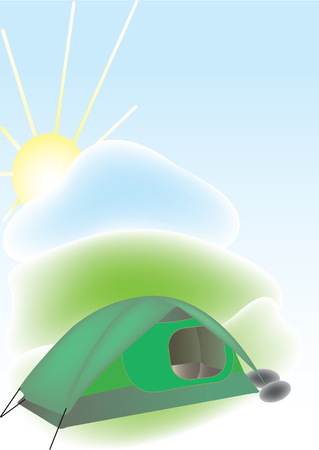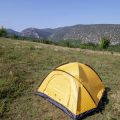1. Why a Quality Sleeping Pad Matters
When youre out camping under the stars, your sleeping pad can make or break your outdoor experience. Sure, you’ve got a cozy sleeping bag and a scenic spot—but without a good sleeping pad, you’re likely in for a long night of tossing, turning, and waking up sore. Let’s explore why investing in a high-quality sleeping pad is essential for any outdoor adventure.
Comfort That Keeps You Going
A great sleeping pad provides more than just a soft surface—it gives your body the support it needs after a full day of hiking, climbing, or paddling. The right pad cushions pressure points like hips and shoulders, helping you sleep better so you wake up refreshed and ready to go.
Insulation from the Cold Ground
Even during summer months, ground temperatures can drop significantly at night. A quality sleeping pad acts as an insulating barrier between your body and the cold earth. This insulation is measured by something called an R-value—the higher the R-value, the better the pad insulates you from the cold.
R-Value Comparison Table
| R-Value | Season | Recommended Use |
|---|---|---|
| 1 – 2 | Summer | Warm-weather backpacking or car camping |
| 2 – 4 | Spring/Fall | Campsites with mild temperature drops at night |
| 4 – 6 | Late Fall/Early Spring | Colder nights or higher elevations |
| 6+ | Winter | Snow camping or sub-freezing conditions |
A Better Night’s Sleep = A Better Day Ahead
No one wants to start their hike feeling groggy and stiff. A quality sleeping pad helps you sleep deeply, minimizing fatigue and muscle soreness. Whether youre tackling rugged trails or enjoying a chill weekend in the woods, good sleep is key to making the most of your time outdoors.
Lighter Weight Without Sacrificing Comfort
If youre backpacking, every ounce counts. Modern sleeping pads are designed to be both lightweight and comfortable. Many top-rated options use advanced materials that pack down small but still offer excellent support and insulation—ideal for thru-hikers or anyone trying to keep their pack weight low.
The Bottom Line: Its Worth It
A cheap foam mat might get you through a night or two, but if youre serious about enjoying your time outdoors—or just want to avoid sore backs and sleepless nights—a high-quality sleeping pad is well worth the investment. In our next section, we’ll dive into what features to look for when choosing the perfect one for your adventures.
2. Types of Sleeping Pads and How to Choose
Choosing the right sleeping pad can make or break your outdoor experience. Whether you’re car camping, backpacking, or heading into the backcountry, there are three main types of sleeping pads to consider: air pads, self-inflating pads, and closed-cell foam pads. Each has its own pros and cons depending on your comfort needs, weight limits, and budget.
Air Pads
Air pads are lightweight and compact, making them a favorite among backpackers. They require manual inflation, usually by blowing into a valve or using a pump sack. Many newer models come with built-in insulation or reflective materials to enhance warmth.
Pros:
- Highly packable and lightweight
- Adjustable firmness
- Often the most comfortable option for side sleepers
Cons:
- Can be punctured or deflate during the night
- Takes time to inflate and deflate
- Tends to be more expensive
Self-Inflating Pads
A hybrid between air pads and foam pads, self-inflating pads contain open-cell foam that expands when you open the valve. These offer a good balance of comfort and insulation without needing much effort to set up.
Pros:
- Easy setup—just open the valve and let it expand
- More durable than air-only pads
- Good insulation for cooler temperatures
Cons:
- Bigger and heavier than air pads when packed
- Might still require a few breaths to fully inflate
- Takes up more space in your pack
Closed-Cell Foam Pads
This old-school option is made from dense foam filled with tiny closed air cells. They don’t inflate at all—they just unroll and you’re ready to go. While not as cushy as other types, they’re ultra-reliable.
Pros:
- No risk of popping or leaks
- Very lightweight and inexpensive
- Doubles as a sit pad or emergency insulation layer
Cons:
- Bigger and bulkier to carry (usually strapped outside your pack)
- Less comfortable—can feel stiff or hard on uneven ground
- No adjustability in firmness
Quick Comparison Chart
| Type | Packing Size & Weight | Comfort Level | Ease of Use | Durability | Best For… |
|---|---|---|---|---|---|
| Air Pad | Compact & Ultralight | High (Adjustable) | Takes time to inflate/deflate | Sensitive to punctures | Backpackers who prioritize comfort & low weight |
| Self-Inflating Pad | Larger & Heavier than Air Pads | Moderate to High | Semi-Automatic Setup | Tougher than air pads but not puncture-proof | Campsites where comfort matters more than weight savings |
| Closed-Cell Foam Pad | Larger but Very Light (Strap Outside Pack) | Basic Comfort Only | No Setup Needed—Just Unroll & Sleep! | The Most Durable Option Available | Bushcraft, ultralight hikers, budget campers, winter trips (as extra layer) |
How to Choose the Right Sleeping Pad for Your Adventure Style?
If You’re Car Camping:
You can afford to bring a thicker, heavier pad since you won’t be carrying it far. Go for maximum comfort with a self-inflating or thick air pad.
If You’re Backpacking:
Your goal is low weight and small packed size. Choose an ultralight air pad—but bring a patch kit just in case!
If You’re Thru-Hiking or Going Ultralight:
A closed-cell foam pad is light, rugged, and reliable. It’s not luxurious, but it’s dependable in any weather.
If You Camp in Cold Weather:
Pads with higher R-values provide better insulation from the cold ground. Consider layering a closed-cell foam under an insulated air or self-inflating pad for extra warmth.
The best sleeping pad is the one that fits your adventure style, sleep preferences, and conditions you’ll be camping in. Understanding these differences helps narrow down your choices before checking out our top picks in the next section.

3. Key Features to Look For
When youre shopping for a sleeping pad for your next camping trip, there are a few key features that can make or break your outdoor sleep experience. The right combination of insulation, comfort, weight, and durability can help you wake up refreshed and ready for adventure. Heres what you need to know:
R-Value: Insulation Matters
The R-value tells you how well a sleeping pad resists heat loss to the ground. The higher the R-value, the better the insulation. If youre camping in colder climates or during shoulder seasons, youll want a pad with an R-value of at least 4. For summer trips, something around 2–3 usually does the trick.
| R-Value Range | Best Use |
|---|---|
| 1 – 2.5 | Warm weather camping |
| 2.5 – 4 | Three-season camping |
| 4+ | Cold weather & winter camping |
Weight: Keep It Light
If youre backpacking or hiking into your campsite, every ounce counts. Ultralight sleeping pads can weigh as little as 8–12 ounces, while more cushioned models might weigh over 2 pounds. Consider how far you’ll be carrying your gear when choosing the right balance between weight and comfort.
Packability: Save Space in Your Pack
A good sleeping pad should pack down small so it doesn’t take up too much room in your backpack. Inflatable and air pads tend to compress smaller than self-inflating or foam pads. Check the packed size before buying—it’s especially important if space is tight.
Durability: Built to Last
Durability is all about materials and construction. If you’re setting up camp on rough ground or using your pad frequently, look for reinforced fabrics like ripstop nylon and TPU coatings. Higher denier ratings generally mean tougher fabric, which helps prevent punctures and wear over time.
Comfort: Get a Good Night’s Sleep
This one’s personal—some people prefer thick air pads, while others like the firm support of foam. Pay attention to thickness (more inches usually mean more cushion) and surface texture (non-slip materials help keep you from sliding off). Also consider the pad’s shape—mummy-style pads save weight but offer less room to move around.
| Feature | Why It Matters |
|---|---|
| R-Value | Keeps you warm by insulating from cold ground |
| Weight | Affects portability; lighter is better for backpacking |
| Packability | Saves space in your gear loadout |
| Durability | Makes your investment last longer through tough use |
| Comfort | Helps ensure restful sleep outdoors |
Understanding these core features will help you choose a sleeping pad that fits your specific needs, whether youre car camping in Yosemite or thru-hiking on the Appalachian Trail.
4. Top Picks for Every Camper
When it comes to choosing the right sleeping pad, there’s no one-size-fits-all option. Whether youre a backpacker counting every ounce, a car camper looking for plush comfort, or someone braving the winter chill, theres a perfect pad out there for you. Weve rounded up ten of the best sleeping pads available in the U.S. market today, each catering to different camping styles and budgets.
Top 10 Sleeping Pads for Different Camping Needs
| Sleeping Pad | Best For | Weight | R-Value | Price Range |
|---|---|---|---|---|
| NEMO Tensor Insulated | Backpackers | 15 oz | 4.2 | $$$ |
| Therm-a-Rest NeoAir Xlite NXT | Ultralight Adventures | 13 oz | 4.5 | $$$$ |
| Klymit Static V2 | Budget Travelers | 16 oz | 1.3 | $ |
| Sea to Summit Comfort Plus Insulated | Cold Weather Camping | 29 oz | 4.0+ | $$$$ |
| Therm-a-Rest Z Lite Sol | Minimalists / Thru-Hikers | 14 oz | 2.0 | $ |
| NEMO Switchback Ultralight Foam Pad | No-Fuss Campers | 14.5 oz | 2.0 | $ |
| REI Co-op Trailbreak Self-Inflating Pad | Beginner Car Campers | 33 oz (Regular) | 5.1 | $$ |
| Klymit Insulated Static V Luxe SL | Larger Campers / Side Sleepers | 35 oz | 4.4 | $$$ |
| Sierra Designs Shadow Mountain Sleeping Pad | Bargain Hunters Who Want Quality | 20 oz (Reg) | 3.0+ | $-$$ |
| TETON Sports Adventurer Camp Pad XL | Cushion-Lovers / Car Campers | 9 lbs+ | N/A (Foam) | $$$ (but worth it) |
A Pad for Every Adventure Style
If You’re Backpacking…
You’ll want something light and compact like the NEMO Tensor Insulated . It packs down small but offers solid insulation for chilly mountain nights.
If You’re Car Camping…
The TETON Sports Adventurer Camp Pad XL offers unmatched comfort with thick foam cushioning—it’s like bringing your bed to camp!
If You’re on a Budget…
The Klymit Static V2 gives you great value without breaking the bank. It’s light enough for short hikes and comfy enough for weekend trips.
If You’re Camping in Cold Weather…
The Sea to Summit Comfort Plus Insulated is built to keep you warm even when temps drop below freezing—perfect for four-season adventurers.
A Quick Tip:
The R-value tells you how well a pad insulates from the cold ground—the higher the number, the warmer youll be.
No matter your style of camping, having the right sleeping pad can make all the difference between tossing and turning or waking up refreshed and ready to explore.
5. Tips for Getting the Most Out of Your Sleeping Pad
Having one of the top sleeping pads is only part of the equation — knowing how to use and care for it properly can make a huge difference in comfort and longevity. Here are some helpful tips to help you get the most out of your sleeping pad, whether youre car camping in a national park or backpacking through the Rockies.
Inflating Your Sleeping Pad
Proper inflation is key to a comfortable night’s sleep. Overinflating can make your pad feel too firm and uncomfortable, while underinflating may not provide enough support.
Best Practices:
- Use your breath or a pump sack: Some pads come with a pump sack that helps avoid moisture buildup inside the pad from your breath.
- Adjust firmness: Once inflated, lie down and release small amounts of air until it feels just right. You should feel supported but not like you’re sleeping on a balloon.
- Inflate before bedtime: Let your pad sit inflated for a few minutes before use so it can reach optimal firmness and shape.
Deflating and Packing Up
Packing up efficiently helps extend the life of your pad and saves space in your pack.
Quick Deflation Tips:
- Open all valves: This allows air to escape faster, especially for self-inflating models.
- Roll tightly from the foot end: Push out as much air as possible with each roll.
- Use the stuff sack: Most pads come with a storage bag that protects it during travel. Don’t force it — fold or roll based on manufacturer instructions.
Cleaning and Maintenance
A clean sleeping pad lasts longer and works better. Dirt, sweat, and oils can break down materials over time.
How to Clean Your Pad:
| Step | Description |
|---|---|
| 1. Spot Clean | Use mild soap and warm water with a soft sponge to clean dirty areas. |
| 2. Rinse & Dry | Rinse with clean water and let it air dry fully before storing. |
| 3. Avoid Harsh Chemicals | No bleach or strong detergents — they can damage fabrics and seams. |
Storage Tips for Longer Lifespan
The way you store your pad when youre not using it matters more than youd think.
- Store unrolled with valve open: For self-inflating pads, this helps retain foam integrity over time.
- Avoid hot or damp places: Keep away from heat sources and moisture to prevent mildew or material breakdown.
- Use a breathable storage bag: Instead of compressing it tight, let your pad breathe in a mesh or cotton sack if storing long-term at home.
Patching Small Leaks
If your sleeping pad starts losing air overnight, don’t panic — many leaks can be fixed easily at home or even at camp with a patch kit.
Troubleshooting Guide:
| Problem | Solution |
|---|---|
| Tiny hole/leak | Dunk in water or spray soapy water to find bubbles; mark and patch with adhesive kit. |
| Slow leak overnight | Add extra air before bed; check valve for tight seal; inspect in daylight when home. |
| Torn seam or valve issue | If under warranty, contact manufacturer; otherwise, use repair tape rated for fabric bonding. |
Treat your sleeping pad well, and itll return the favor by giving you many nights of cozy rest under the stars. Whether youre using an ultralight inflatable for thru-hiking or a thick foam pad for family camping trips, these tips will keep you sleeping soundly wherever adventure takes you.

